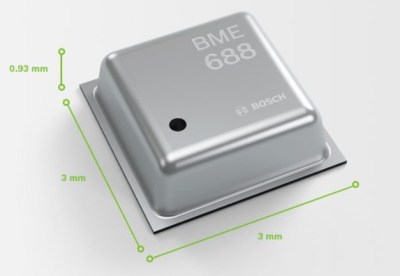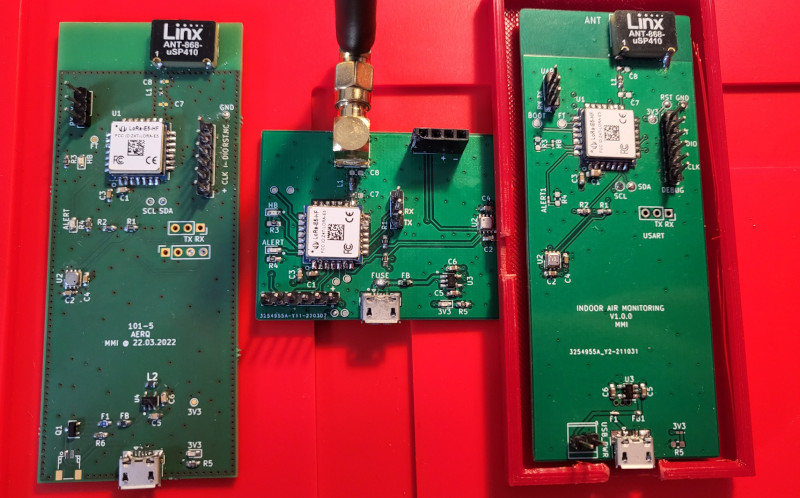We’ve seen an incredible number of homebrew environmental monitors here at Hackaday, and on the whole, they tend to follow a pretty predicable pattern. An ESP8266 gets paired with a common temperature and humidity sensor, perhaps a custom PCB gets invited to the party, and the end result are some values getting pushed out via MQTT. It’s a great weekend project to get your feet wet, but not exactly groundbreaking in 2022.
Which is why we find the AERQ project from [Mircea-Iuliu Micle] so refreshing. Not only does this gadget pick up temperature and humidity as you’d expect, but its Bosch BME688 sensor can also sniff out volatile organic compounds (VOCs) and gases such as carbon monoxide and hydrogen. The datasheet actually claims this is the “first gas sensor with Artificial Intelligence (AI)”, and while we’re not sure what exactly that means in this context, it’s a claim that apparently warrants a price tag of $15+ USD a pop in single quantities.

But the fancy sensor isn’t the only thing that sets AERQ apart from the competition. Instead of a member of the ubiquitous ESP family, it’s using the Wio-E5, a relatively exotic STM32 package that integrates a long-range LoRa radio. [Mircea-Iuliu] has paired that with a Linx USP-410 chip antenna or, depending on which version of the four-layer PCB you want to use, a u.Fl connector for an external antenna. The whole thing is powered by a simple USB connection, and its Mbed OS firmware is setup to dump all of its collected data onto The Things Network.
All told, it’s a very professional build that certainly wouldn’t look out of place if it was nestled into some off-the-shelf air quality monitor. While the high-end detection capabilities might be a bit overkill for home use, [Mircea-Iuliu Micle] points out that AERQ might provide useful insight for those running indoor events as COVID-19 transitions into its endemic stage.
















great AQI monitor project.
Particulate Matter is very useful for human safety air quality monitoring.
thanks for posting
Air quality measurement are even more useful when there a more sensors, so i run one these sensors for a couple of years now: https://sensor.community/en/
But the BME688 looks interesting although in my experience reliable ambient temperature measurement is not possible with these small sensors on a pcb next to other components that generate heat and often in an enclosure,
The sensors are very reliable and consistent with proper isolation, power management, and a thermal ground plane on your PCB. All they need is a little calibration.
I put an AHT10 and BMP180 inside the Ikea VINDRIKTNING and get very stable measurements that, after calibration, align with my Honeywell Thermostat’s temperature.
https://i.imgur.com/Pz4jaRs.jpg
https://i.imgur.com/1L0tDap.png
As a newbe to building sensors like this, how do you calibrate a temperature sensor?
Looking at the datasheet, I think the “AI” component is actually their closed source algorithms that are part of their “BME AI-Studio”. Without any formal definition for “AI”, it wouldn’t be a stretch marketing to classify some set of algorithms as an expert system.
In short, it’s almost certainly all bluster with zero substance.
Bluster, yes. It might have a use if you were producing a very specific model for a narrow application. But for general purpose use, I doubt it adds anything.
Do we know if the sensor truly detects CO2 or is it like the other cheapie modules that assume all CO2 in an environment comes from human sources (rather than, for example a fire) and just assumed that VOC is a proxy for CO2?
It is estimated CO2 so not very useful. Some other manufacturer like Sensirion are moving away from doing eCO2, e.g. their newest TVOC sensors SGP4x do not have eCO2 anymore.
Lotsa wide open green space on them boards. Why? Golf range for small insects maybe?
Ground is probably part of the antenna.
Low frequency RF like lora performs better like this.
For Covid-19 purposes, you want to monitor carbon dioxide levels (not carbon monoxide), as an indication for how well ventilated a space is. Though this article only mentions carbon monoxide, the datasheet mentions:
“CO2 equivalents (ppm)
Estimation of the CO2 level in ppm. The sensor does not
directly measure CO2, but derives this from the average
correlation between VOCs and CO2 in human’s exhaled
breath.”
Had a LuftDaten project sensor (https://sensor.community/en/) outside for over 2 years now, and this would make a great upgrade since the present one measures only particulates and also is largely mechanical
Required certifications (e.g. radio emissions, FCC, …) will add some not neglibigle costs to the unit cost.
What enviro sensor is complete without a Radon gas sensor? Lots of basements could use that value for peace of mind or to trigger remediation. Lung cancer is the risk.
I am maintaining a popular open source air quality monitor measuring CO2, PM2.5, Temperature, Humidity and optionally TVOC.
The CO2 Sensor we use is using NDIR and measures the gas directly and is thus much more accurate than the estimated CO2 from the Bosch sensor in this project.
https://www.airgradient.com/open-airgradient/instructions/